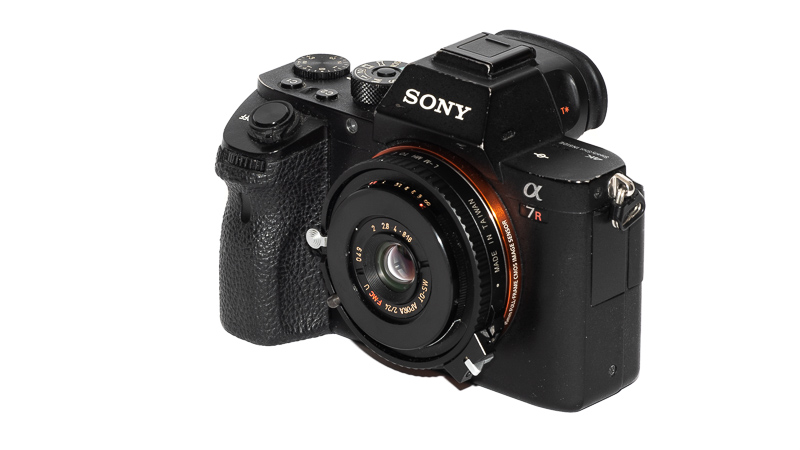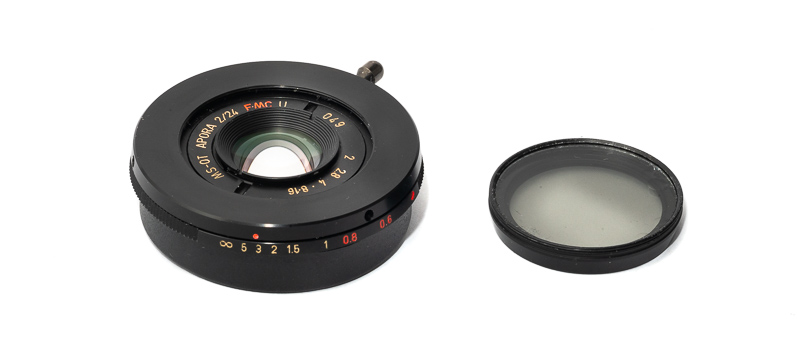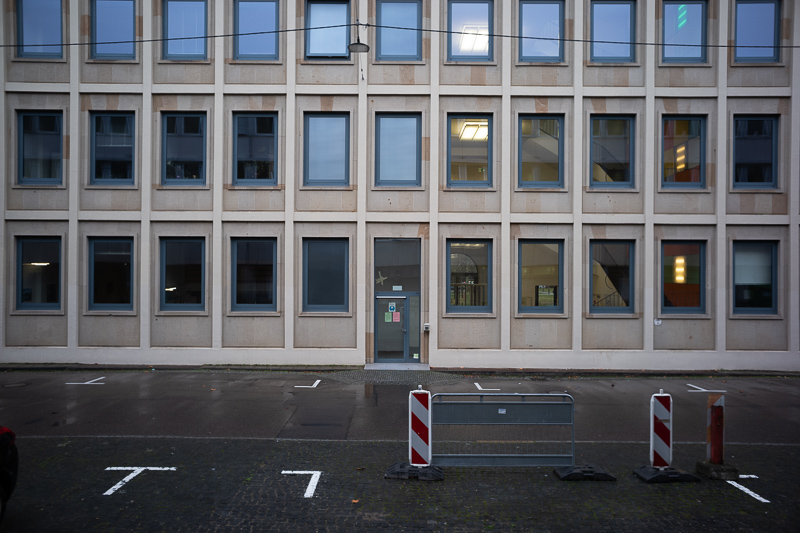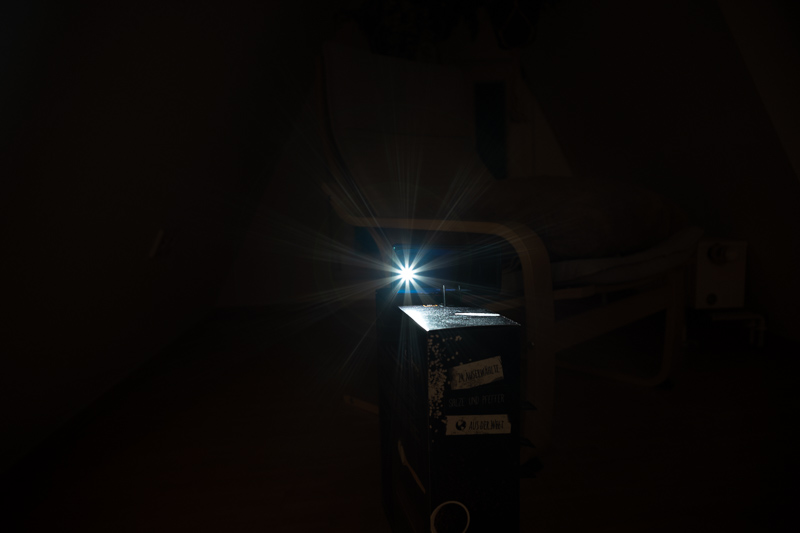Introduction

Whenever some lens is advertised as “the smallest lens ever made” we usually get to deal with some junky fixed focus and fixed aperture pinhole lens. The MS-Optics 24mm 2.0 Aporia is a very different story though, only 45g and less than 6mm in length but with a maximum aperture of f/2.0, a real diaphragm and rangefinder coupled focus mechanism. But there must be compromises, right?
Lens is being tested on 42mp Sony A7rII and 24mp Leica M10
Last update: April 2025
Sample Images










You can find most of the sample images in full resolution here.
Contents
Specifications / Version History
You can find out more about MS-Optics lenses in my Overview covering all their M-mount lenses. This 24mm 2.0 is one of its kind and has the following specifications:
-
- Diameter: 47mm
- Field of view: 83° (diagonally)
- Length: 5.8mm
- Weight: 45g
- Filter Diameter: 34mm*
- Number of Aperture Blades: 10 (straight)
- Elements/Groups: 6/4
- Close Focusing Distance: 0.5 m
- Maximum Magnification: 1:10.8 (measured)
- Mount: Leica-M
*a normal 34mm filter will not fit, you are supposed to salvage one and put (or glue) only the glass from it in the small lens hood provided, see handling section
You can only find this lens at japancamerahunter or on ebay.com (affiliate link) but don’t expect it to be always available.It sells for about $1200
Handling / Build Quality

There is a lot to talk about here. On focusing the whole lens rotates and while I am usually not a big fan of focus tabs here the small lever comes in handy. It rotates ~120° from the minimum focus distance (0.5m) to infinity. The lens is rangefinder coupled between 0.8 m and infinity.
Setting the desired aperture is a bit fiddly as the whole inner ring (including all the markings) serves as aperture ring. There are two grooves, but especially with big hands it remains fiddly and there are also no click stops. A small silver dot marks the current f-stop.
The lens is seriously tiny, it is a bit thicker than a body cap but also smaller in diameter:

The small diameter comes with a caveat though: on the Leica M10 the 6-bit-code-reader is not fully covered and therefore under bright light the camera will often think you changed the lens and throw you ouf of live view should you be using that (and you should with this lens). I added a small piece of duct tape which solves the issue:

The lens also comes with a tiny 34mm screw in metal lens hood. It ruins the look of the lens a bit, so I don’t like to use it, but it is necessary if you want to use a filter.
First you need a 34mm filter than you can salvage using a camera spanner tool, you also better hope the diameter of the glass element is not slightly too big (already happened to me).
Then you put that glass element in the lens hood and attach the lens hood to the lens.
You will not be able to set the aperture anymore now, without removing the filter first.
Small trivia: there is a typo on the lens, while officially it is called “Aporia” it merely says “Apora” in the writing. Not the first MS-Optics lens with a typo.
Vignetting
light falloff

Considering the dimensions we were expecting high vignetting, right? We did not get disappointed, at f/2.0 I measure 3.9 EV in the corners, this improves steadily on stopping down, at f/2.8 it is still 3.0 EV, at f/4.0 it is 2.6 EV and if we stop down further it improves to f/2.4 EV.
Values on the Leica M10 are similar and within the margin of error.
While this does sound high and also is high remember that lenses like the Voigtlander VM 15mm 4.5, Voigtlander 21mm 1.4 or Leica 35mm 1.4 FLE don’t do much better.

It is recommended to have a look at this article first to get an idea how this brightness graph works.
color cast
Sensor design makes a big difference here. On the A7rII we have very minor green color cast in all the 4 corners, which is what we have often seen in the past with other wide lenses as well.
On the M10 the situation is very different: the left side of the frame shows almost unnoticeable green color cast while the right side of the frame shows more obvious magenta color cast.
Similar to what we have seen with the Voigtlander VM 15mm 4.5 SWH II.
You can check out my article How to: Correcting Color Cast in Lightroom where I explain different methods to fix this.
Sharpness
MTF-Graphs

The MS-Optics lenses always come with hand-drawn MTF-graphs which do give a hint what to expect.
What we see is that astigmatism is well corrected whereas field curvature is very high. We will investigate in the following sections what that means.
infinity (42mp Sony A7rII)

The MTF-graphs above are telling us there is an area in the midframe with a noticeable dip in resolution whereas the corners are slightly better than that. Obviously the MTF do not take into account Sony’s thick filter stack, so let us have a closer look.
The center looks decent from f/2.0 whereas the midframe is clearly out of focus (field curvature) and the corners plagued by strong coma.
The center receives a boost of contrast on stopping down to f/2.8 whereas for the corners it needs stopping down to f/11 for decent performance. Even at f/11 or f/16 the midframe is still not in the same focal plane as center and corner.
For the midframe I am showing the worst part inbetween center and corner, it is where the dip in the MTF is visible.
Let us see in the next section how the lens performs on a camera with a thinner filter stack.
infinity (24mp Leica M10)

Performance on the Leica M10 with its thinner filter stack is significantly better despite a lower resolution sensor.
At f/2.0 the midzone dip is also visible here but not as severe.
Also on stopping down to f/8.0 or f/11 we get even across frame performance, sufficient for landscape or architecture subjects.
For the midframe I am again showing the worst part inbetween center and corner.
portrait distance (0.9 m)
For portraiture it isn’t so important how flat the field is, it is more interesting to see what the sharpness is like when focused at different parts of the frame to take field curvature out of the equation, especially when dealing with lenses with a high amount of field curvature like the MS-Optics 24mm 2.0 Aporia.

This is what I did here, I refocused for every shot to get the best possible result at different locations in the frame (center, inner midframe and outer midframe).
Focus distance was roughly 0.9 m and the circle of the dollar bill is more or less the size of a human eye.

When we move away from the center we are loosing contrast, but astigmatism is indeed well corrected so when boosting contrast in post we can still get usable results with the subject outside the rule of thirds intersections.

On the Leica M10 the loss of contrast looks a bit lower and we may see finer details, but we also need to take into account that we are looking at crops from 24mp files, not 42mp ones.
For a lens like this I think it is a sensible approach to try to correct astigmatism as good as possible while allowing for higher field curvature. At f/11 we get decent across frame performance anyway, at f/2.0 we can place our subject anywhere in the frame and get satisfactory results at the point of focus.
close (0.5 m, 1:10.8)
100% crops from center, Sony A7rII
A minimum focus distance of 0.5 m is not bad for a 24mm Leica M lens. Of course the lens does not feature a floating elements design, so stopping down a bit is not a bad idea if you want really crisp images at these distances.
Flare resistance

As always evaluating flare is a complex matter since you can get any lens to look bad if you push it hard enough and a slight change of scenario can affect results a lot.
Nevertheless, the MS-Optics 24mm 2.0 is not a great performer when it comes to work against bright light. The multicoating seems to keep contrast at a reasonable level but with the sun in the frame – especially stopped down – you can often catch frame filling ghosts and the aperture diaphragm is also doing its part here, leading to internal reflections as it seems.
This is not to say that it is impossible to take pictures in backlight situations. When taking some care during framing even with the sun inside the frame nice results can be achieved:

Coma
100% crops from extreme corner, Leica M10
Fast wide angle lenses are generally prone to coma and this being a rather simple 6 element gauss design does not allow for plenty of correction elements found in current retrofocus designs. Stopped down to f/8.0 or further it clears up nicely though.
Distortion
Leica M10 | MS-Optics 24mm 2.0 Aporia | f/5.6
The lens shows only minor yet slightly wavy distortion. When you dial in -3 it is mostly corrected towards the borders but the center gets worse. When I have some spare time I may create a correction profile.
Sunstars
The MS-Optics 24mm 2.0 Aporia is using 10 aperture blades, but the alignment leaves something to be desired, as the opposite rays do not overlap perfectly. At f/11 and f/16 it also looks like we are seeing internal reflections again. I would have preferred a little nicer, but we should also remember this is probably the smallest 10 blade aperture diaphragm I have ever see and will ever see.
If you want to learn more about this topic have a look at this article.
Bokeh

When dealing with a pancake lens we should not expect amazingly smooth bokeh, so let us have a look what we are getting here.

First we are dealing with the “overcorrected spherical aberration” type of bokeh that e.g. the Zeiss Loxia/Biogon 35mm 2.0 is famous for. It leads to noticeable outlining of point light sources:

This is the case for f/2.0 and f/2.8 whereas stopped down to f/4.0 or further the outlining disappears. It also means that double edged structures can appear around contrasty edges:

We also have to take the high field curvature and vignetting into account, combined they lead to the corners showing less blur than the center:

You can also try to cover this up by not correcting the vignetting as much (see first picture in this section) or making sure there are no distracting structures in the corners (see next picture).
Nervertheless, more often than not the background blur is undistracting and even with bigger objects (or persons) a noticeable subject isolation can be achieved:


How we rate the bokeh of the MS-Optics 24mm 2.0 Aporia in the end? Considering it is a pancake lens I am impressed. If we compare it to legacy lenses of the same focal length and maximum aperture like the Nikon 24mm 2.0 Ai-s or the Olympus OM 24mm 2.0 it holds up very well. Even if we compare it to modern fast 24mm lenses only the latest ones like the Sony FE 24mm 1.4 GM are optimized towards smooth bokeh.

But this is a personal subject matter, so use the sample images provided to see if you like the look or not.
Chromatic Aberrations
lateral
This 24mm 2.0 is a mostly symmetrical design which usually means little to no lateral CA and this is also the case here. There are only minor traces visible which are easily corrected either in camera (for Jpegs) or in a raw developer like Lightroom by one click.
longitudinal

Despite the fast maximum aperture only minor longitudinal CA are visible. The MS-Optics 24mm 2.0 Aporis is not the best corrected lens I have seen yet, but I think the “Apo” in the name is still justified.
Alternatives
There aren’t any real alternatives available with similar specs at a similar size. Merely the MS-Optics 28mm 2.0 Apoqualia comes to mind if you think a 28mm lens is an alternative to a 24mm lens.
Due to the absence of 24mm framelines this is also not a popular focal length among Leica users, we only have an Elmarit 2.8/24, Summilux 1.4/24, Biogon 2.8/25 and the Voigtlander 4/25 none of which is really comparable.
For E-mount we of course have the Batis 2/25, Loxia 2.4/25 and the GM 1.4/24 and while they can often be found for less than the asking price of this MS-Optics 2/24, already their lens caps are bigger than this lens, so I doubt anyone will be deciding between these options.
Conclusion
good
|
average
|
not good
|
As a Leica user:
MS-Optics lenses are often described as “quirky”, by which people usually mean “technically bad”. I am clearly not a fan of generalization and the Aporis 2.4/135 was already a good example what Miyazaki is capable of and that this is not always the case. Nevertheless my expectations of a 45g “heavy” 24mm lens with a maximum aperture of f/2.0 were not that high.
Handling sure is quirky: the whole lens barrel rotates, setting the aperture takes some fiddling and good luck finding a 34mm polarizer…
But optically, the MS-Optics 24mm 2.0 Aporia is more useful than anyone should expect given its size: it sharpens up nicely across frame stopped down, loCA are corrected surprisingly well, the bokeh is of the overcorrected SA type at f/2.0 and f/2.8, but hardly worse than e.g. a Zeiss Biogon 2/35, Astigmatism is low, so it is sharp at focus point at f/2.0, vignetting is very high at f/2.0, but stopped down no worse than other compact (meaning: significantly bigger) rangefinder lenses and it even focuses down to 0.5 m.
Still, this is of course not a bread-and-butter lens. You have to work around its limitations. You don’t buy this because you need a 24mm lens for your job, you buy it because you want it, because you find the form factor appealing, because it looks cool on your Leica camera, because you want something different from the “mainstream” lenses or simply because you enjoy the idea of a single guy in Japan making these odd lenses that no one else is making.
Lenses like this are the reason I am keeping the Leica M10.
As a Sony user

Even when adding an M-to-E-adapter the MS-Optics 24mm 2.0 Aporis is still very tiny, but – as was already the case with the Voigtlader VM 15mm 4.5 SWH II when using it on a Sony camera – it looses its pancake character and therefore its purpose is kinda ruined.
The thick filter stack also doesn’t help, making it harder to achieve even across frame sharpness stopped down and lowering off center sharpness at wider apertures a bit.
You can only find this lens at japancamerahunter or on ebay.com (affiliate link) but don’t expect it to be always available.It sells for about $1200
Further Sample Images

































You can find most of the sample images in full resolution here.
Further Reading
- Sony FE lenses: Our comprehensive and independent guide
- Guide to the best 85-135mm Portrait Lenses for Sony a7 series
- 35mm comparison Leica, Zeiss, Voigtlander
- Review: Sony FE 24mm 1.4 GM
Support Us
Did you find this article useful or just liked reading it? Treat us to a coffee!
![]()
![]()
![]() via Paypal
via Paypal
This site contains affiliate links. If you make a purchase using any of the links marked as affiliate links, I may receive a small commission at no additional cost to you. This helps support the creation of future content.
Latest posts by BastianK (see all)
- 2025 – Year in Review - December 23, 2025
- Review: Sony FE 70-200mm 4.0 G Macro OSS II - December 20, 2025
- Review: Viltrox AF 35mm 1.2 FE LAB - December 17, 2025



























Incredible little lens. Hard to believe its only 1 Stop slower than the 1.4/24GM.
$1200 for such a mediocre lens? That’s ridiculous!
But the doctors and lawyers with their Leicas will happily pay for it because it “distinguishes” them. LOL. Facepalm.
Limited series, one-man production, it’s practically home-made lens, thus the price. This is not a mass-production item but someone’s personal project and limited series, so the price doesn’t really have to be that competitive. Of course I won’t buy it, but if a thousand euros more or less didn’t mean a thing I would consider it. After all, I’d support an enthusiast, not a huge company; so I wouldn’t really feel like throwing the money away. I don’t think this lens (with a typo on it even) can be used as a so-called “status symbol”, like the Leica cameras. For me it was interesting to see a different approach to lens design and something I didn’t think quite possible (not that I’m an expert), and this review has satisfied my curiosity. Thanks Bastian!
It’s frankly amazing to find such a remarkably decent lens of this size, with such a wide aperture, made by a single person. I’m never going to own a Leica but hell, if I shelled out 10k for a camera, a lens like this would be exactly what I’d be looking for. Thanks for reviewing these lenses which are close to unknown at least here in the West. Merry xmas lad.
Not for this kind of price tag, but really interesting lens. I do like the 3D pop from it. It has that something…The flares remind me of Triplet t43 lens from Soviet Lomo cameras, that lens has kind of similar flare, nevertheless it has good center sharpness, people even use it for macro, there was m39 version of it.
7artisans just announced a quite similar (form factor) 35mm f/5.6 M-mount pancake lens.
Are there any plans to review it?
Thanks to the team, and have a blessed christmas 🙂
No, a 35mm f/5.6 is rather useless to me.
At 125g and with fixed aperture I may add.
Pancake lenses are interesting and funny, but this is too much overpriced for such standard performance. Many older 24mm lenses are better performers in my opinion.
Show me those older 24mm f/2 lenses that are better.
an Olympus OM24/2.8 or f2 should be close…
Yeah, similar I agree, not better.
Sony Distagon T* 24mm F2 ZA SSM?
only 15 times the weight 😉
Frankly, will you reasonably pay $1200 for such a “stone” ?
Indecent
Another great review, thanks.
And another great set of examples of how to get really good pictures from lenses with certain technical flaws. I was thinking you could (if you wanted), do a meta-article on that subject using existing reviews… a “How to get good photos from bad lenses” article with you all contributing.. anyway, just an idea. The main point is saying thanks and well done on the photos again.
Exactly! The image qualilty of the lens is not decicive, its the capabilities of the photographer that make the difference!
Great review—I’ve been eyeing this 24/2. I own the MS-Optical 73/1.5 and 35/1.4 and sold the 28/2.
I really like them for what they are—absolutely quirky lenses that are fast and have good IQ stop down with lots of character wide open.
They deliver a specific look, some more than others. Comparing these lenses to mass produced larger autofocus glass doesn’t make a lot of sense to me as the trade-offs between size/auto focus/convenience/ergo/image quality/rendering and overall are so different. And if you only have enough money for one, the MS-Optical lenses will probably drive you insane unless you are a very special type of photographer.
Anyway, I appreciate the review, and I think this is one of your most compelling set of images. Great work and Merry Christmas 🙂
Hello Bastian,
thank you for that review. I had to wait long reading such an informative review. I know that MS-Optical lenses are not easy to use und that many people hate, and some love this lenses. I love this lenses. Owning the 2/28 Apoqualia and the 1,5/73 Sonnetar I know what these lenses are about. You cant`t just shoot some pics, no you have to learn using this lenses. But if you take your time and show some patience you will get great pictures with this lenses. Anyway I love waking around in big cities with the tiny 2/28 Apoqualia and shoot in the dim light. Therefore these lenses are made and they are worth each cent.
Best regards,
Christian
Thank you for your feedback!
As you see from the former comments opinions vary greatly here 🙂
I would review more of the MS-Optics lenses, but obviously I don’t get loaners and they are too expensive to buy just to write a review.
Needless to say these reviews generate zero income from affiliate links.
Great Review Bastian. Appreciate the work from all of the reviewers on this site. I would totally love to try this lens on the A7c. Even with adapter it will hardly be longer than the grip, keeping it very compact.
Yes this is true, it is also one of the smallest lenses you could find for the A7 series cameras.
As the M10 has no grip (at least by design) this lens makes the camera go pockets where it couldn’t go otherwise, that is kind of a big advantage.
Just bought one today while I really think that it is a wonderful lens but focusing cam seems to be off
I could not get it to focus correctly.
Do you know Is there any way to adjust it ?
While the 1.1/50 and 1.5/73 can be adjusted I know of no way to do that with the 2/24.
Is infinity reached?
Thank you and sorry for asking around so much.
I am just new to the blog and webpage things so I tried you on FB…
I think will find technician around my area to work on it.
Have a wonderful day
Give me one? OK, I’ll take it. But pay? Never.
Hmm. A hand-made 24mm f/2 lens with at least decent rendering qualities and decent performance that is as small and light as an Olympus BCL 15mm f/8? Of course it’s going to be pricey. 🙂
Just ordered one. I’ve wanted a small, light ‘casual shooting’ lens for my Leica CL for some time. This seems to be the ticket.
Hope you will enjoy it 🙂
Hello BastianK,
How well with this lens work on a Leica SL2-S?
Thank you for your time.
Ah I don’t have an SL2-S, but from what I know it has thicker cover glass than M10 and thinner than Sony, so compared to what I am showing here I expect a little worse than on M10 and a little better than on Sony 🙂
Thank you – I’ll continue my quest for some type of SL/SL2-S samples with this lens. It’s like you say – it’s not really a lens you need – it’s a lens you want.
Often people select melodious names for their products without knowing anything about their meaning, and sometimes this leads to strange results. When German car manufacterer VW called an expensive car “Phaeton”, they obviously did not read the myth about Phaeton, the son of the Greek sun god Helios, who borrowed his father’s sun cart and died in flames because he was not able to drive it.
So this lens has also a strange name. “Aporia” is ancient Greek, yes, like some other words used in lens and camera names (“Heliar”, “Ikon”, etc.), but the word has nothing to do with optics, it just means “embarrassment”, “perplexity”, “helplessness” ;–).
Please don’t get me wrong – if a lens is great, I do not care about its name! But I still wonder why people wo want to name a product do not just ask the world wide web – in seconds we are told about the meaning of “aporia”, so it would have been easy to avoid such a delicate name … ;–).
Thank you so much for the review! This is very informative. The best review I have read on MS lenses. Do you happen to have experience with MS 28/2? They appear to have similar design and I wonder if they perform similarly as well.
No, unfortunately not. All the MS lenses I have used there is a review here 😊
Hi TC,
I own the Apoqualia 2/28mm. The optical prformance ist a bit different than that of the here reviewed Aporia. The reason therefore is that the Apoqualia has a quite different field curvature. You can generate really great 3D-pops but you can`t do landscape shooting, because you will never get sharp edges. Anyway I still love my Apoqualia and if you know how to use it, its a great performer. I love it for street photography in dim light…
Best regards, Christian
Hi Bastian,
beeing familiar with MS-Optics lenses and all their quirks, the 24mm Aporia seems performing quite well. Of course it also depends on the eye of the photographer, and You are doing a really good job!
I would interprete the field curvature beeing a kind of donut-shaped. How does the Aporia perform, shifting the focus a bit?
I guess you should be able to produce pictures with a slightly more even “sharpness” over the whole field, without the need of stopping down that much.
But nevertheless I`m very impressed what mr. Miyazaki can make out of a simple double Gauss formula, and I´m quite shure that this is the next MS-Optics lens finding it`s way to me… 😉
Best regards, Christian
Hello is this lens 1. rangefinder coupled and 2. 6-bit coded or at least doesnt cause the Leica M10 to think there is no lens as some lenses do? Thanks!
Please actually read the review to find your answers, they are all already there.
The filter thread for this lens is 33mm. I was able to find a 33mm to 40.5mm step up ring on aliexpress if anyone wants to use a more readily available filter size.
Thank you Bastian for just another wonderful review! The more often I read this review the more I try to find an Aporia. Only with no success so far. Is there anyone in the community willing to sell a copy? I would be very grateful for some hints.
Many thanks again, Stefan